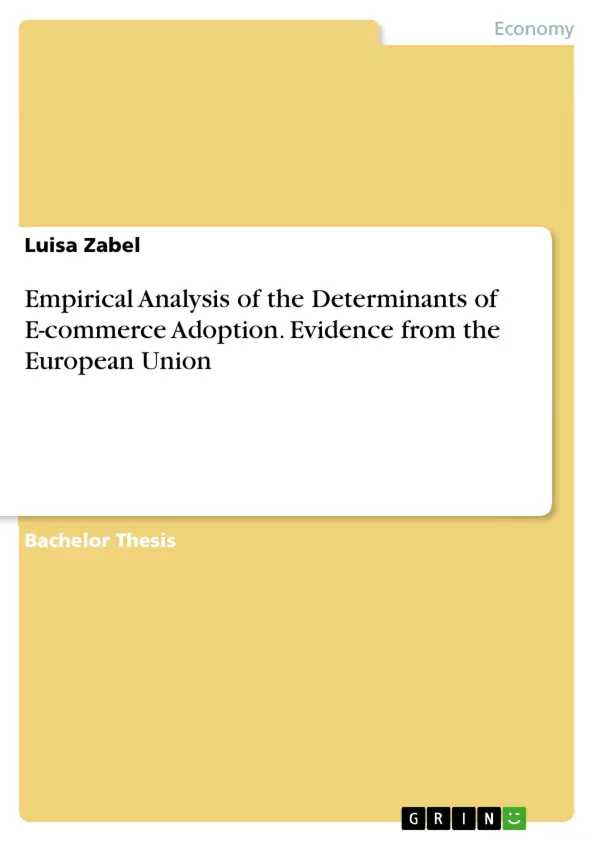Motivated by a rising popularity and economic as well as political importance of the E-commerce sector, this research investigates how the high-speed broadband internet coverage and the usage intensity of people influence the share of web buyers in a country. This question is examined by studying a comprehensive panel data set covering the EU-28 member states in the period from 2003 until 2018.
Findings suggest that a more widespread availability of fixed broadband internet exerts a significant positive influence on the amount of online shoppers, while mobile broad-band connectivity is found to be adversely related. Furthermore, the results claim that the more frequent internet users, the higher the national percentage of internet purchasers. These outcomes are of relevance to all stakeholders with interest to push the devel-opment of the European E-commerce sector further.
Bill Gates has once predicted that the internet is becoming the town square for the global village of tomorrow. Being a vision at that time, current developments show that this statement addresses no longer only the future - it has never before described the present so suitably. Within the last years, the internet has evolved to be a central information hub for individuals and is nowadays tightly embedded into our everyday life.
Information on nearly everything can be gathered from the web, a big part of social life takes place in the virtual sphere and the internet has entered the professional space a long time ago - the progressing digitalization moves a steadily increasing share of activities online. Since access to high-speed internet is vastly increasing, people get accustomed to an ubiquitous connectivity.
One application of the internet that steadily gained popularity for many years now re-lates to an initial purpose of the "town square", which used to be the location of a market. Facilitated by the broad deployment of network technologies and their rapid devel-opment, companies increasingly offer their products via online channels. Consumers value the convenient shopping experience accessible around the clock and benefit from a greater variety of merchandise as well as often lower prices. Firms profit by cost savings, an augmented customer base and new sales options in return.
Inhaltsverzeichnis (Table of Contents)
- 1 Introduction
- 2 Related literature
- 2.1 Literature on psychological determinants and socio-demographics influencing the online purchasing behavior
- 2.2 Literature on the impacts of broadband on various economic outcomes
- 3 Framework development
- 4 Data
- 4.1 Sample construction
- 4.2 Introducing the variables
- 4.2.1 The dependent variable
- 4.2.2 Explanatory variables
- 5 Econometric model
- 6 Estimation results
- 6.1 Main estimation results
- 6.2 Results of subgroups of individuals
- 6.3 Robustness checks and limitations
- 7 Discussion
- References
- Abbreviations
- Appendix
Zielsetzung und Themenschwerpunkte (Objectives and Key Themes)
This research aims to analyze how the availability and usage of high-speed broadband internet influence the share of web buyers in a country. It investigates the impact of fixed and mobile broadband connectivity on online purchasing behavior within the European Union (EU-28). This research examines a comprehensive panel data set covering the period from 2003 to 2018, seeking to provide insights for stakeholders interested in promoting the development of the European E-commerce sector.
- The influence of high-speed broadband internet on online shopping behavior.
- The impact of fixed broadband internet coverage on the share of web buyers.
- The relationship between mobile broadband connectivity and online purchasing.
- The role of internet usage intensity on the national percentage of internet purchasers.
- Implications for stakeholders involved in the development of the European E-commerce sector.
Zusammenfassung der Kapitel (Chapter Summaries)
The research begins with an introduction providing the context and motivation for studying the determinants of E-commerce adoption. Chapter 2 reviews relevant literature, focusing on the psychological factors and socio-demographic influences impacting online purchasing behavior and exploring the effects of broadband on economic outcomes. Chapter 3 outlines the framework developed for the study, laying the foundation for the empirical analysis. Chapter 4 delves into the data used in the research, including details on sample construction and an introduction to the key variables, such as the dependent variable (share of web buyers) and explanatory variables (broadband coverage, internet usage intensity). Chapter 5 discusses the econometric model employed for analysis. Chapter 6 presents the estimation results, highlighting the main findings and exploring the results for subgroups of individuals. Additionally, it examines robustness checks and limitations of the study. Chapter 7 provides a comprehensive discussion of the research findings and their implications for the development of the European E-commerce sector.
Schlüsselwörter (Keywords)
The study focuses on key concepts such as E-commerce adoption, broadband internet coverage, internet usage intensity, online purchasing behavior, panel data analysis, European Union, and economic development.
- Quote paper
- Luisa Zabel (Author), 2019, Empirical Analysis of the Determinants of E-commerce Adoption. Evidence from the European Union, Munich, GRIN Verlag, https://www.grin.com/document/914320



